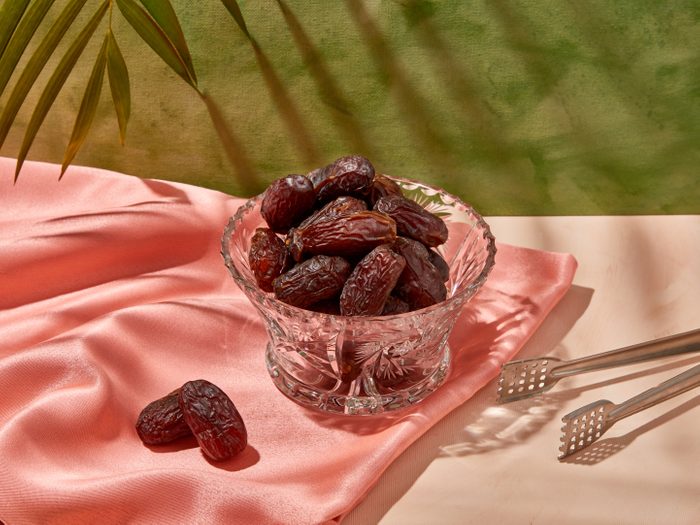This Is Why Medjool Dates Make the Perfect Sweet Snack

Also called "the king of dates," Medjool dates are full of fibre, vitamins and minerals.
You always remember your first good date. One nibble in, and you’re courted by a deep caramel flavour, soft texture and delightfully sweet taste. For me, it was love at first bite, and dates and I are in a long-term relationship.
Growing up with a Middle Eastern parent, I was introduced to dates at a young age. Lazy Sunday afternoon lunches were often finished with fresh fruit and dates that were hoisted down from a high-up cupboard like a secret stash. They were also always a part of the holiday dessert table along with trifle and fruit cake, an edible representation of the merging of my parent’s’ two cultures merging. From then on it was clear to me that no matter when I ate them, dates were a delicacy.
(Related: 8 Healthy Plant-Based Snacks You’ll Actually Want to Eat)
Having been traced as far back as 50 million years, dates are the world’s oldest cultivated fruit. They are the fruit of the date palm tree, which thrives in desert climates and is native to the Middle East and North Africa, where they’ve been a staple in the diets of Arab countries like Morocco, Egypt and Saudi Arabia for centuries. Dates grow in large clusters, similarly to grapes, and are suspended up to 75 feet in the air on lofty palm trees. Date palms are unique in that they are either male or female plants. The male plants produce pollen, but neither birds nor bees are attracted to it, so the female plants are carefully pollinated by hand by date farmers. The plum-size fruit starts off bright yellow and then deepens to an amber colour as it ripens. Each individual date matures at its own pace, so those that are still yellow are set aside picked out and left to ripen further in the sun.
In the 1900s, an American botanist named Walter Swingle travelled to the Middle East in search of exotic foods to bring back to the U.S. He discovered that the temperatures required for growing dates were similar to that of the Coachella Valley in Southern California and brought back a cutting of a date palm tree to plant there. The date palms thrived in California, and have been grown there ever since, currently producing 95 percent of the dates grown in the U.S.
(Related: 16 Strawberry Recipes That’ll Sweeten Up Your Summer)
There are many varieties of dates, but Medjool dates are the largest and sweetest, and have the highest moisture content. This results in a soft, plump texture, with a delicate skin and a jammy interior. Medjools are often referred to as the “king of dates” because they were once reserved for Moroccan royalty and their guests. Great care is still taken to harvest this regal fruit: Medjool dates are hand-picked and sorted to ensure they are at the correct ripeness. This also explains their higher price tag—it’s because they’re worth it!
Dates are high in sugar, which concentrates as they dry. But what dates have that other sweets don’t is fibre—two Medjool dates have more than 3 g of fibre, which is about 15 percent of your daily recommended intake. Fibre helps mitigate potential blood sugar crashes, as it slows the absorption of glucose into the bloodstream. Dates’ vitamin and mineral content also sets them apart from plain white sugar. They contain trace amounts of iron and calcium, and are a source of potassium, a nutrient that regulates fluid balance in the body and is important for proper nerve transmission, muscle contraction and kidney function.
(Related: Raw vs. Cooked: How to Get the Most Out of Your Vegetables)
Choose dates with a glossy exterior and without any cracks in the skin. If they look overly wrinkly, they’re likely a bit on the dry side. Also look for dates that are separate and intact, not stuck together in a big clump, as this is a sign their skin is broken or torn. To expand the lifespan of your dates, store them in an airtight container in the fridge to help them retain their moisture longer.
To use dates in cooking, first slice lengthwise and pop out the pit inside—and then put them to work in both sweet and savoury dishes. Medjool dates are soft enough to purée without having to soak in water first, and once they’ve broken down, the paste can be used as a natural sugar alternative in baking and beyond. Try substituting date paste in homemade muffins, loaf cakes and granola bars for more complex flavour and added fibre. In California, they’re used in the popular date shake, an indulgent drink made by blending ice cream, dates and milk.
To give savoury dishes a sweet boost, add chopped pitted dates to cooked couscous pilaf, to the traditional Moroccan stew tagine or toss in a pan with roasted Brussel sprouts and bacon—an unexpected yet winning combination.
Next, try this Medjool date recipe for date-coconut energy bars.




